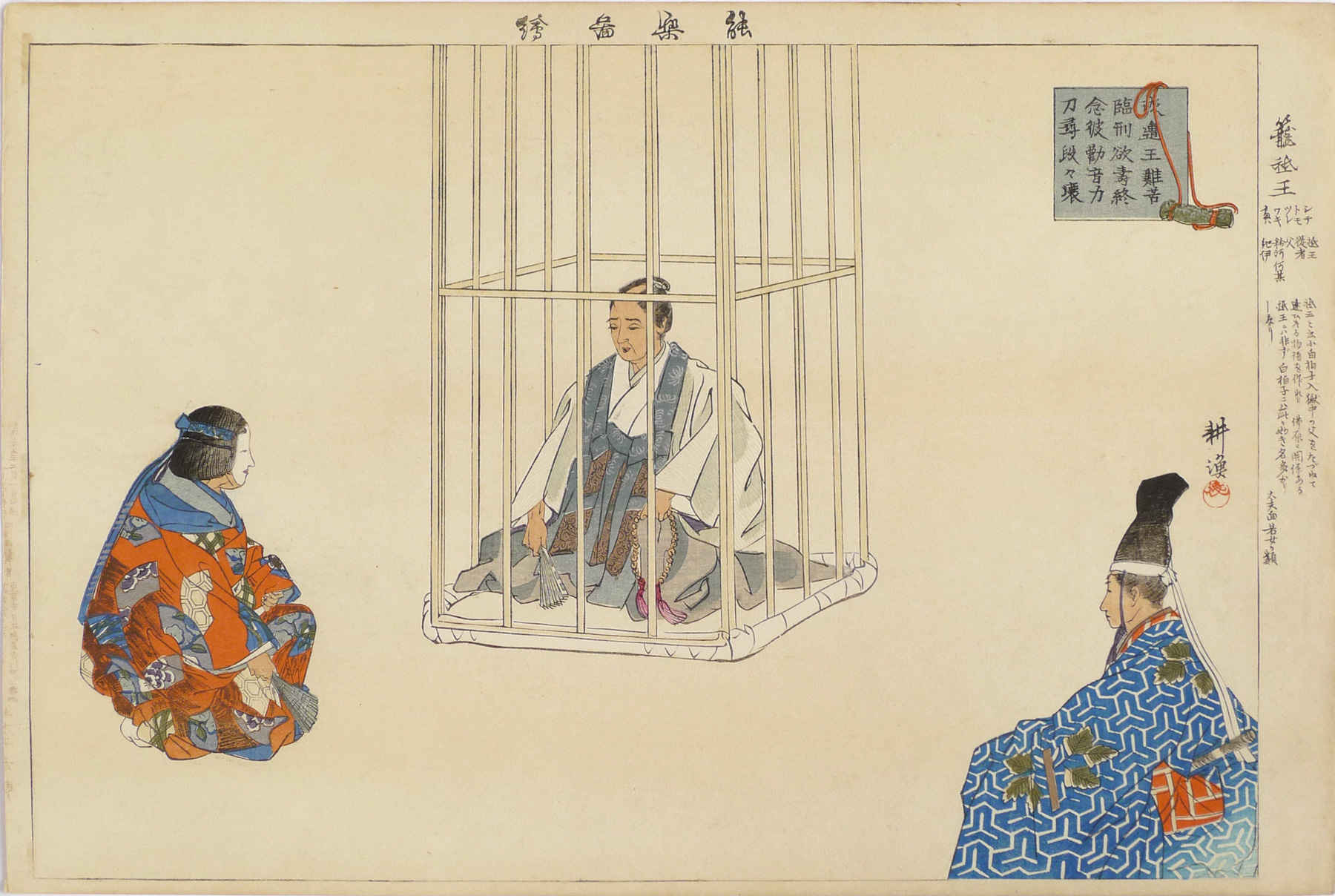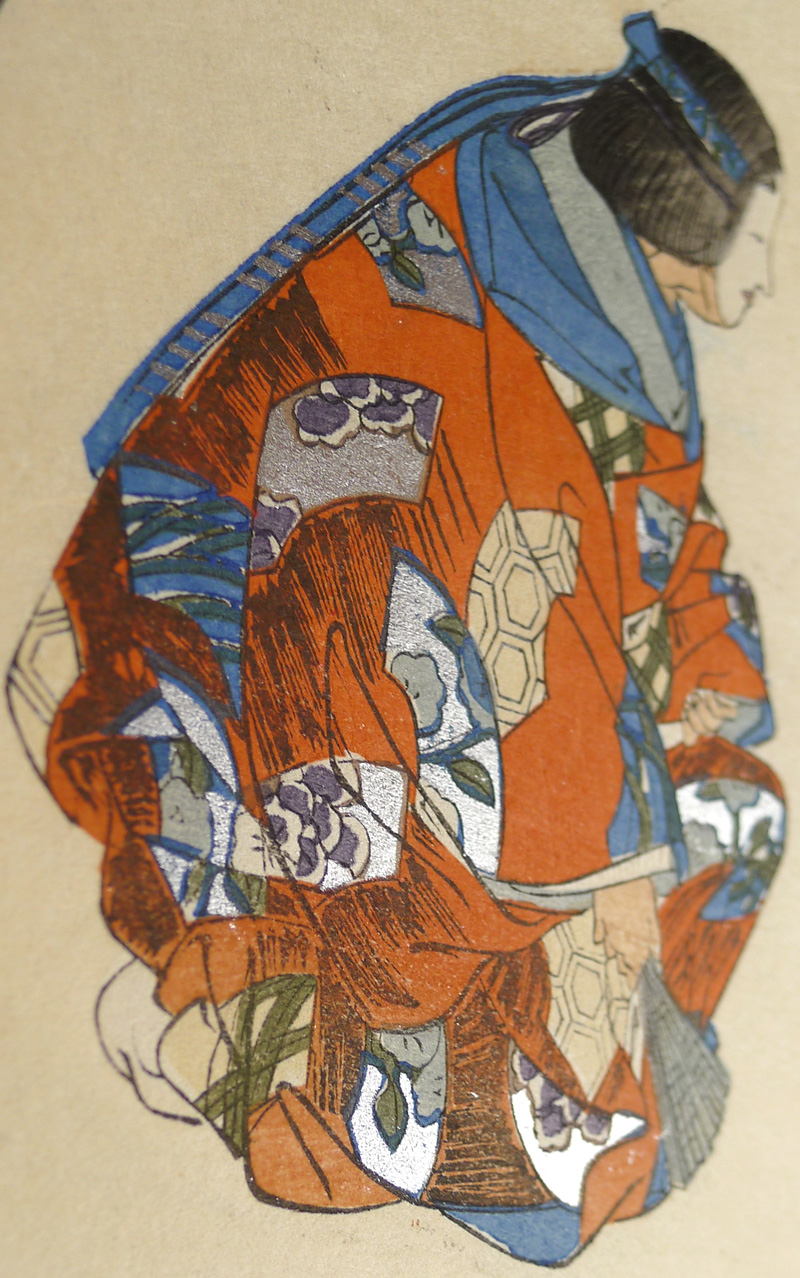About This Print
1 website of Prof. M. Watson at Meijigakuin University in Tokyo. A checklist of translations of 253 Noh plays in alphabetical order. http://www.meijigakuin.ac.jp/~pmjs/biblio/noh-trans.html
click on image to enlarge
silver mica highlights are used on the robes throughout this series
silver mica highlights are used on the robes throughout this series
The Play - Rō Giō
Source: Like Clouds or Mists Studies and Translations of No Plays of the Genpei War, Elizabeth Oyler and Michael Watson editors, East Asia Program, Cornell University, 2013 https://muse.jhu.edu/chapter/1603915Rō-Giō (Giō at the Prison) is a genzai play in two acts. It formerly was part of the Kita school repertoire, but it is no longer performed. The playwright is unknown. The shite of Rō-Giō is Giō, the famous shirabyōshi 白拍子 dancer from Heike monogatari, but little in the play is derived from the source text. Rō-Giō opens with a michiyuki 道行 (travel song), has a dance as its visual center, and turns on a miraculous last-minute reprieve granted by the deity Kannon.
Rō-Giō opens with Giō, and her attendant traveling from the capital to Kogawa, in Kii province, where Giō’s father has been imprisoned. They are met by a man from Kowaka who has been charged with guarding Giō’s father. Giō is at first unaware of the nature of her father’s crime. The guard agrees to let her meet with her father in exchange for a dance: Giō’s fame as a shirabyōshi has reached even this remote village. Giō is united with her father and learns of his crime: while he himself was serving as a jailer, he freed an innocent man, an act Giō praises. The two lament their imminent parting, and the guard intervenes to request that Giō dances. Although weighed by her sorrows, she is prodded into performing by her father. She dances, and then the execution is to take place. Miraculously, however, the sword cannot hit its mark—it has been shattered, we are told, by Kannon’s divine intervention to protect the innocent.
Print Details
| IHL Catalog | #204 |
| Title | Rō Giō 籠祇王 (Giō at the Prison) |
| Series | Nōgakuzue 能樂圖繪 (Illustrations of Noh) |
| Artist | Tsukioka Kōgyo (1869-1927) |
| Signature | Kōgyo 耕 漁 |
| Seal |  Red letter seal in a round shape: 漁 [Gyo] Red letter seal in a round shape: 漁 [Gyo] |
| Date | Printed on February 1, 1902 / Issued on ? - date is trimmed and unreadable (Meiji 35) 明治三十五年二月一日 |
| Edition | unknown |
| Publisher | Matsuki Heikichi (Daikokuya Heikichi 大黒屋平) [Marks: pub. ref. 029] |
| Carver | |
| Impression | excellent |
| Colors | excellent |
| Condition | good - slightly trimmed along left margin; not backed, minor soiling, light toning |
| Genre | ukiyo-e; 能楽図絵 Nōgaku zue [Noh play picture] |
| Miscellaneous | silver metallic highlights on robes of courtesan Giao and her imprisoned father |
| Format | oban yoko-e |
| H x W Paper | 9 3/8 x 14 1/8 in. (23.8 x 35.9 cm) |
| H x W Image | 8 3/4 x 13 in. (22.2 x 33 cm) area within printed black border |
| Collections This Print | University of Pittsburgh 20091209-kogyo-0444 |
| Reference Literature |



